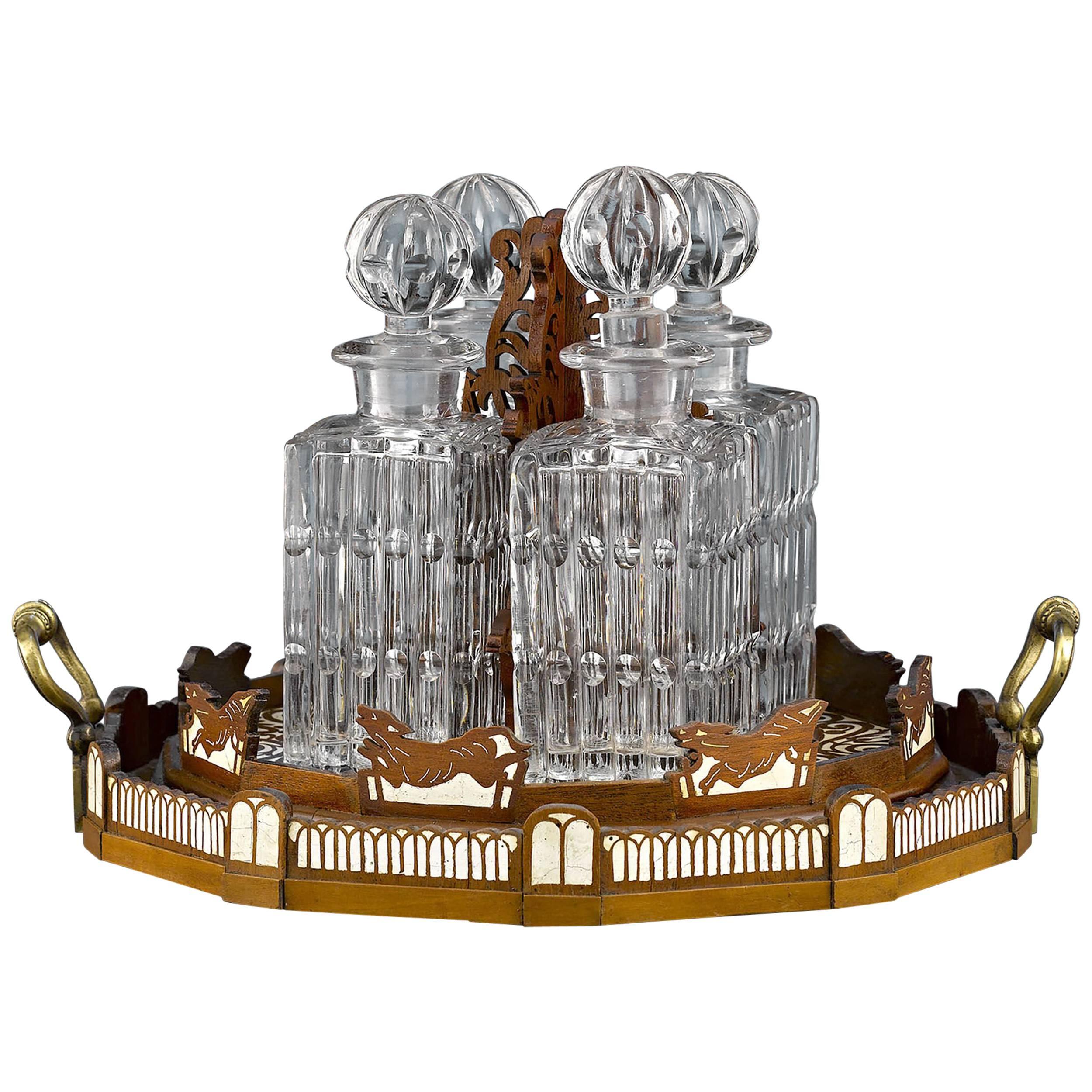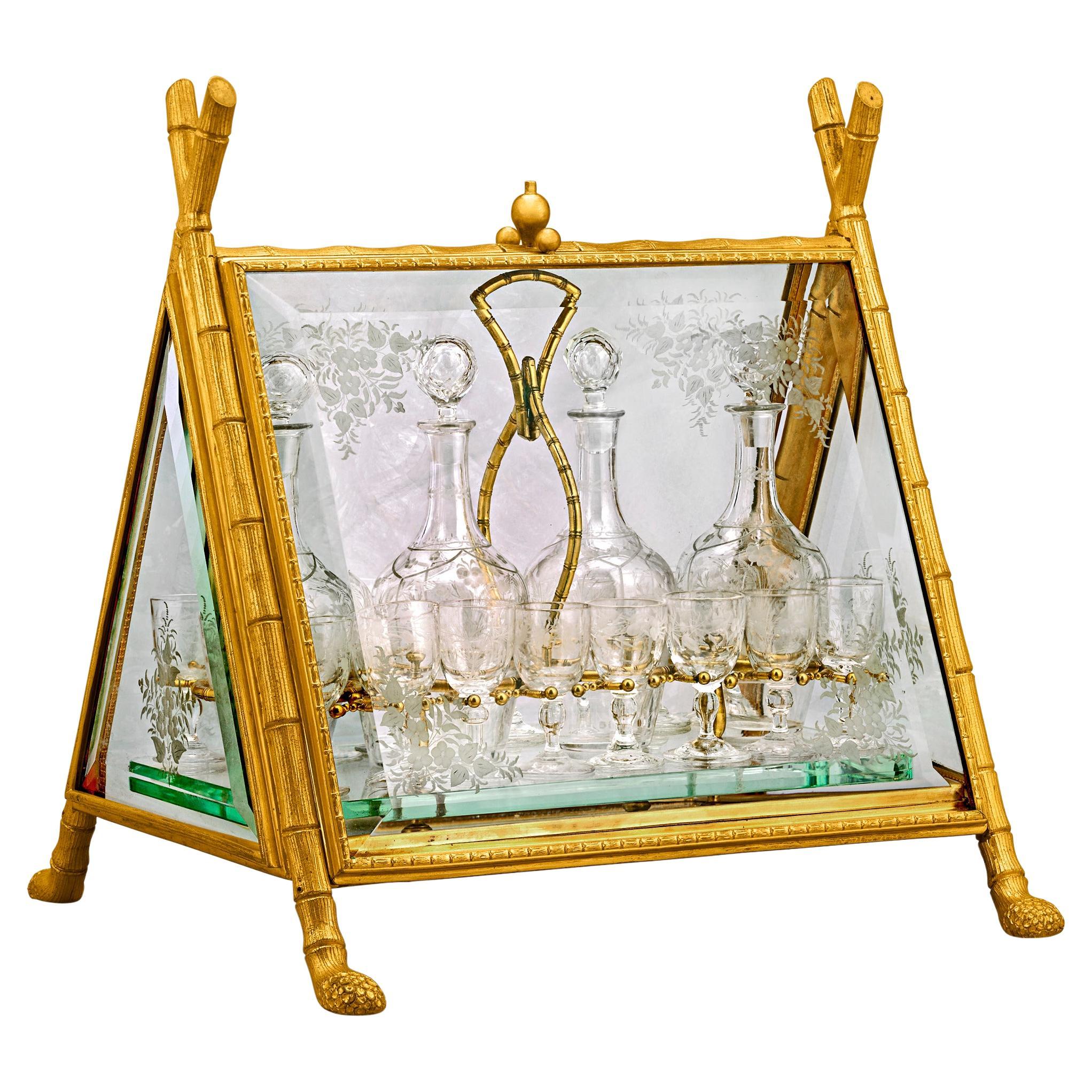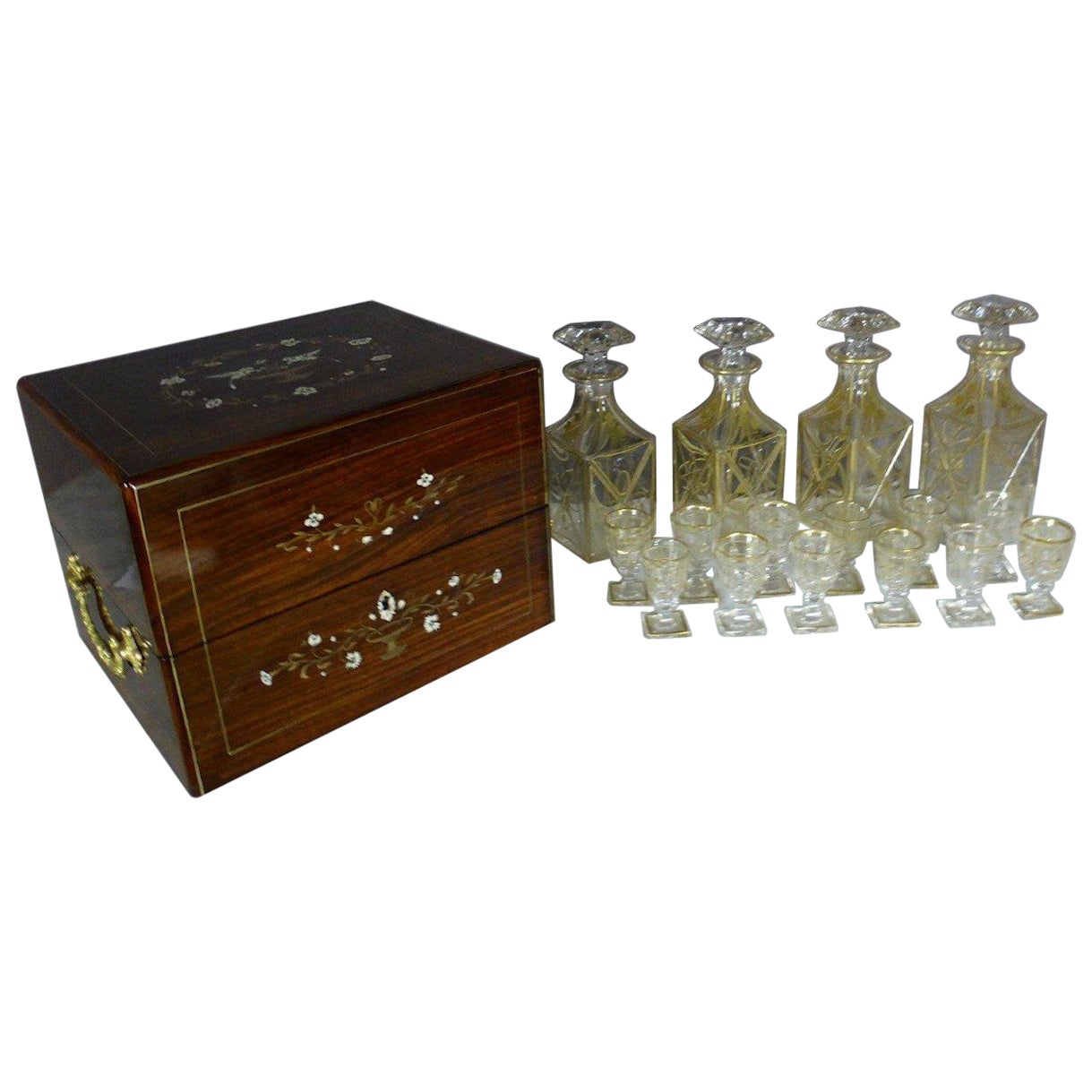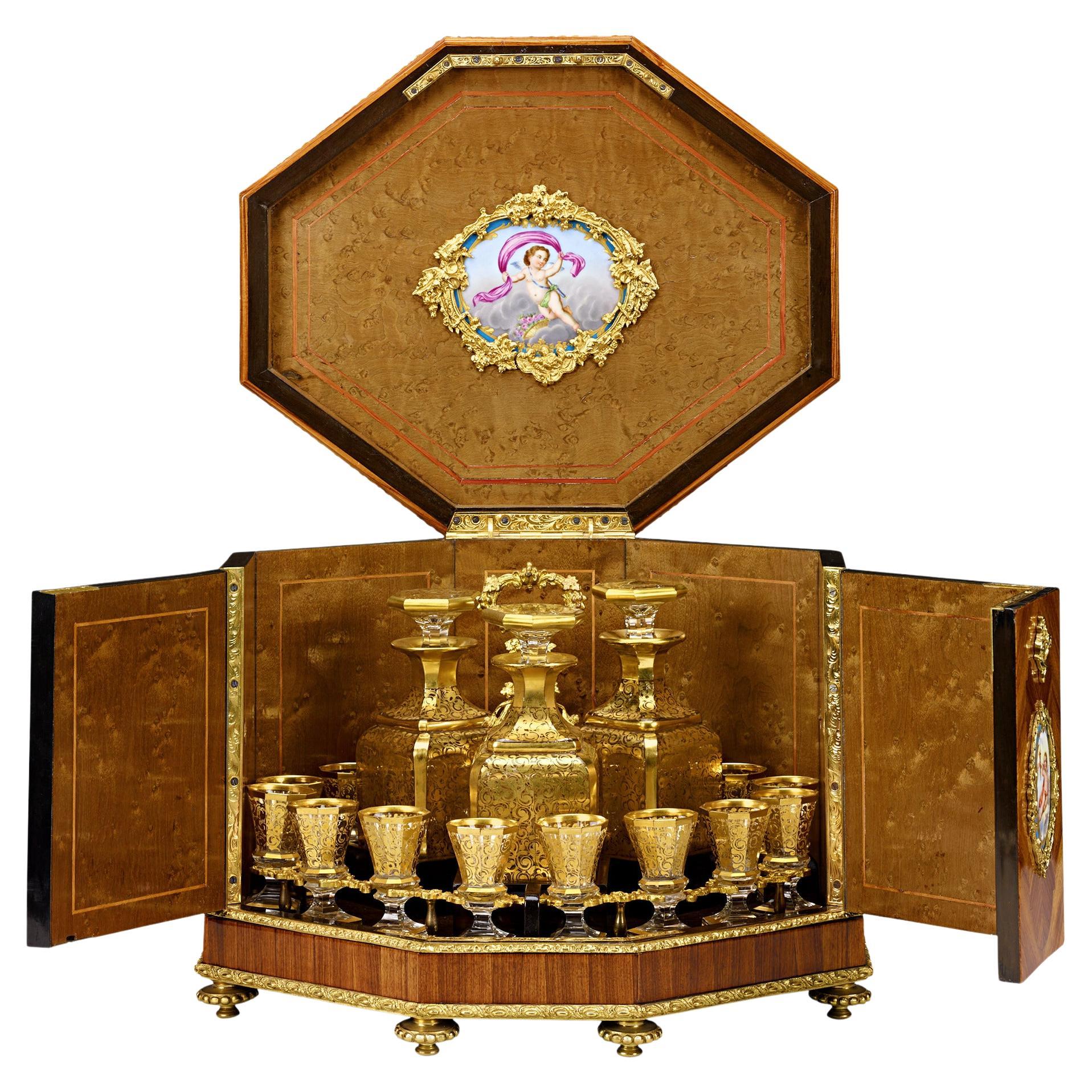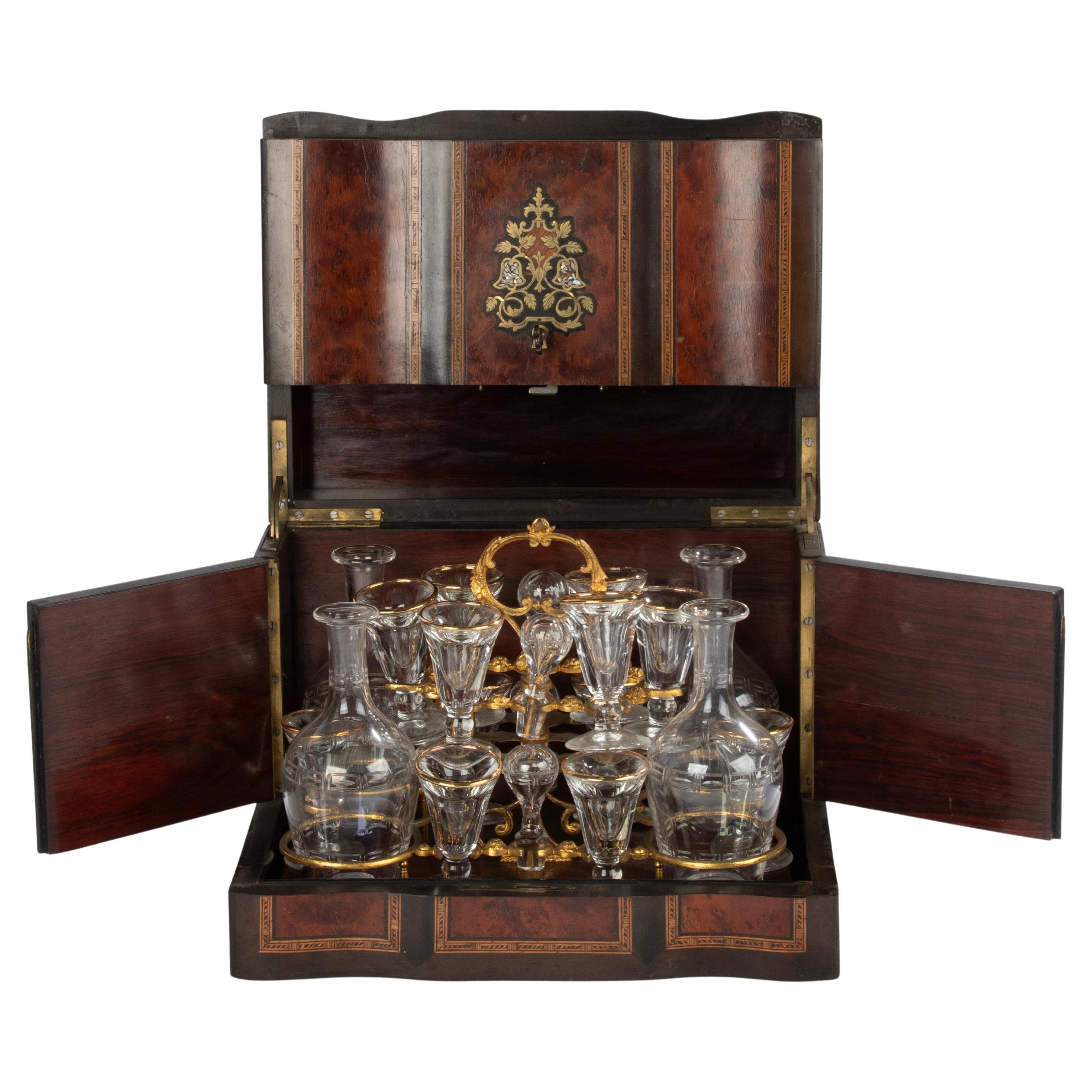Items Similar to Exquisite Baccarat "Elephant" 'Cave A Liquor' - Exposition Universelle 1878
Video Loading
Want more images or videos?
Request additional images or videos from the seller
1 of 22
Exquisite Baccarat "Elephant" 'Cave A Liquor' - Exposition Universelle 1878
About the Item
The Magnificent Baccarat Elephant Cave A Liquor: A Majestic Exploration of a Timeless Masterpiece from the Exposition Universelle of 1878.
The Baccarat Elephant Cave A Liquor, created for the illustrious Exposition Universelle of 1878, stands as an exceptional work of art, crafted from frosted glass and cut crystal. Inspired by the iconic Elephant of Bastille, this extraordinary creation represents the pinnacle of Baccarat's artistry and exemplifies the rich historical significance associated with the renowned 1878 exhibition.
Elevating the allure of this stunning creation, the Baccarat Elephant Cave A Liquor comes complete with four raised gold and overlay glass bottles, allowing you to savor the liquor of your choice, accompanied by twelve shot glasses that gracefully rest on the saddle of the elephant.
I. The Design and Symbolism:
The design of the Baccarat Elephant Cave A Liquor is a testament to the artistic vision of its creators. Drawing inspiration from the Elephant of Bastille, a colossal statue commissioned to celebrate the French Revolution and a symbol of strength, resilience, majesty and good fortune, this masterpiece exudes a sense of grandeur and historical reverence. Every contour and line of the Baccarat Elephant is carefully crafted, capturing the majesty and strength associated with the original Bastille monument. The inclusion of the liquor compartment within the elephant's back adds a functional element to its design, seamlessly merging artistry and practicality.
II. Frosted Glass and Cut Crystal:
The choice of materials for the Baccarat Elephant Cave A Liquor exemplifies Baccarat's commitment to excellence. Frosted glass, known for its delicate translucence and soft texture, lends an ethereal quality to the elephant's appearance. This frosty effect, achieved through acid etching or sandblasting, diffuses light and enhances the overall aesthetic. Complementing the frosted glass, the intricate details of the elephant's body are expertly carved from cut crystal. Crafted with meticulous attention to detail, the frosted glass exterior bestows an ethereal radiance upon the masterpiece, while the cut crystal accents accentuate its brilliance, creating a captivating interplay of light and reflection. The addition of Ormolu, a lavish gold alloy, infuses an opulent touch, further enhancing its aesthetic appeal. Baccarat's mastery in crystal craftsmanship is evident in the precision of the cuts and the resulting brilliance, captivating the viewer with its scintillating play of light.
Unlock a world of sophistication and indulgence as you delight in the functional aspects of the Baccarat Elephant Cave A Liquor. The four raised gold and overlay glass bottles, designed to hold your preferred liquors, provide an exquisite presentation that showcases the richness of their contents. With each sip poured into the accompanying shot glasses, which elegantly perch on the elephant's saddle, every moment becomes an elevated experience of refined pleasure.
This exceptional piece not only serves as a luxurious centerpiece but also holds a deeper symbolic meaning. Elephants, revered in many cultures as bringers of good luck, bless your surroundings with their presence. The Baccarat Elephant Cave A Liquor invites you to embrace the positive energy and prosperity associated with these majestic creatures, creating an ambiance of fortune and abundance within your space.
With its historical significance, meticulous craftsmanship, and remarkable functionality, the Baccarat Elephant Cave A Liquor holds immense desirability and market value. It is an exquisite addition to any discerning collector's ensemble, a conversation starter that evokes admiration and intrigue. Whether displayed as a centerpiece in your luxurious bar or cherished as a cherished heirloom, this masterpiece is an investment in both artistry and taste.
III. The Exposition Universelle of 1878:
The Exposition Universelle of 1878, held in Paris, was a significant event in the history of art and culture. As a platform for innovation and creative expression, the exposition showcased the finest achievements of the era. Baccarat, renowned for its exquisite crystal creations, seized this opportunity to present the Baccarat Elephant Cave A Liquor, cementing its reputation as a purveyor of luxury and elegance. The presence of this masterpiece at the exposition further solidified Baccarat's position as a leading force in the world of fine craftsmanship.
IV. Artistic Legacy and Collectability:
The Baccarat Elephant Cave A Liquor is not merely a decorative object but an embodiment of artistic legacy and historical significance. Its association with the Exposition Universelle of 1878, coupled with Baccarat's distinguished craftsmanship, endows this piece with immense collectability and cultural value. As a coveted artifact among connoisseurs and collectors, its rarity and desirability have only grown with time. Owning the Baccarat Elephant Cave A Liquor grants one entry into an exclusive realm where art, history, and luxury converge. Indulge in the allure of the Baccarat Elephant Cave A Liquor and elevate your luxury collection to new heights. Own a piece of history, embrace the charm of the Elephant of Bastille, and celebrate life's special moments with unrivaled elegance and sophistication.
Elephant: 25" high x 23.5" wide x 9.25" deep.
This 'elephant' liqueur tantalus set is in overall excellent condition. Ready to place. Minor rubbing to some areas of ormolu on base.
This model was first exhibited in the Glass Pavilion at the 1878 Exposition Universelle in Paris. Although Baccarat was awarded a gold medal for another artistic creation, this piece was purchased by the Marharaja of Baroda in honour of the Feast of the Elephant in India. The model was inspired by architect Jean-Antoine Alavoine's fountain project which was commissioned by Napoleon in 1808 to the site of the infamous Bastille prison. The Elephant de la Bastille as it was then known was never built, but a monumental model of the fountain made out of wood and plaster stood on the site of the present Opera Bastille between 1813 and 1846.
Provenance:
Private European Collection since early 1990's.
Comparative Literature:
M. Lerch and D. Morel, Baccarat, The Legend of Crystal,Catalogue of the Exhibition at the Petit Palais,
October 15th 2014-January 4th 2015, memorial exhibition of 250 years of the factory of Baccarat.
D. Sautot, Baccarat, Paris, 1998.
J.-L and V. Curtis Nansenet, Baccarat, Paris, 1991.
M. Beauhaire Mr. Béjanin, H. Naudeix, Napoleon's Elephant, Verona, 2014.
*A comparable model is located at The Hôtel Crillon, Paris.
Ambani
- Creator:Cristalleries De Baccarat (Maker)
- Dimensions:Height: 25 in (63.5 cm)Width: 23.5 in (59.69 cm)Depth: 9.25 in (23.5 cm)
- Style:Napoleon III (Of the Period)
- Materials and Techniques:
- Place of Origin:
- Period:
- Date of Manufacture:C. 1875
- Condition:Wear consistent with age and use.
- Seller Location:New York, NY
- Reference Number:1stDibs: LU1798235266772
About the Seller
5.0
Vetted Seller
These experienced sellers undergo a comprehensive evaluation by our team of in-house experts.
Established in 1980
1stDibs seller since 2016
58 sales on 1stDibs
Typical response time: <1 hour
- ShippingRetrieving quote...Ships From: New York, NY
- Return PolicyA return for this item may be initiated within 7 days of delivery.
More From This SellerView All
- Rare French Ormolu and Diamond-Cut Crystal Figural Inkwell Encrier by BaccaratBy Cristalleries De BaccaratLocated in New York, NYA rare French Ormolu and diamond-cut crystal figural inkwell Encrier by Baccarat, circa 1875. Depicting a cherub with books, with the finest ormolu mounts, this exquisite jewel...Category
Antique 19th Century French Napoleon III Inkwells
MaterialsCrystal, Bronze, Ormolu
- A Monumental "Exhibition" Pair Of Baccarat Opaline Glass Bronze Mounted VasesBy Cristalleries De BaccaratLocated in New York, NYAn Important and Monumental "Exhibition" Pair Of French Baccarat Opaline Opaque Glass Bronze Mounted Vases and Covers, Most Certainly Made For The Exposition Universelle of 1878. In...Category
Antique 19th Century French Napoleon III Vases
MaterialsBronze
- A Large French Baccarat Opaline Glass Hand-Painted "Bacchanale" Vase, by RousselBy Cristalleries De BaccaratLocated in New York, NYA Large French Baccarat Opaline Glass Hand-Painted "Bacchanale" Vase, by Roussel, circa 1885. Presenting an exquisite and highly coveted piece of artistry, behold the large French O...Category
Antique 19th Century French Napoleon III Vases
MaterialsGlass
- Cristalleries De Baccarat, a Large French Cut-Crystal Tsarine TorchereBy Cristalleries De BaccaratLocated in New York, NYCristalleries De Baccarat, A Large French Cut-Crystal Twenty-Four Light Tsarine Torcheres, Standing Floor Chandelier. "A Magnificent Chandelier" Each central stem issuing twenty-four out-scrolled candle branches suspending prisms and bell-flowers, on four splayed supports, in the Indian Maharaja style, stamped BACCARAT throughout. 86" high x 33" wide Wired for electricity. In overall excellent condition. The torchère is fully complete and there are no damages associated.Ready to place. Comparative Literature: Lerch, Moscou, Splendeurs des Romanov, Exhibition catalogue, 11 July – 13 September 2009, Monaco, pp. 214-217. M. Lerch, Baccarat: la légende du cristal, Exhibition catalogue, 15 October 2014 – 4 January 2015, Paris, pp.68-69. D. Sautot, The Story of Baccarat, Paris, 1993. Cristalleries de Baccarat: The origins of the manufacture, also known as the Compagnie des Cristalleries de Baccarat, can be traced to 1764. On this year, King Louis XV accorded to the Bishop of Metz permission to establish a glass factory on his land, in the small village of Baccarat in Lorraine, in order to compete with the celebrated Bohemian production. Lorraine is traditionally a glass-making region, due to the abundance of silica in the soil and due to its large forests, which supplied the wood to fuel the ovens. Francois-Eugène de Fontenay, who joined the company in 1841, discovered that the addition of nickel oxide in the manufacturing process resulted in a perfectly clear product, 'crystal glass', that was free of discoloration and that imitated precious rock crystal. For this discovery, the Baccarat company was awarded a gold medal at the French Expositions des Produits de l'Industrie in 1844. Continually experimenting with their manufacturing process, the quality of Baccarat's 'crystal glass' improved, reaching the highest level by the end of the century. The Baccarat manufacture rapidly became a leading producer with highly skilled maître-verriers. In 1823, Baccarat participated for the first time at the National Exhibition. Louis XVIII was seduced by the quality of the pieces presented, which received the praise of the jury and the first gold medal. As a result of their success and innovations, the manufacture gradually consolidated its reputation, which allowed it to dominate the French market. The Russian fascination for Baccarat: In 1867, Tsar Alexander II visited the Exposition Universelle in Paris and fell in awe in the sight of Baccarat’s stand...Category
20th Century French Floor Lamps
MaterialsCrystal
- Rare Art Nouveau French Ormolu and Crystal Inkwell Encrier by BaccaratBy Cristalleries De BaccaratLocated in New York, NYA Rare Art Nouveau French Ormolu and crystal inkwell Encrier by Baccarat, circa 1900, the ormolu possibly by Francois Linke. Depicting a reclined winged maiden...Category
Early 20th Century French Art Nouveau Inkwells
MaterialsCrystal, Bronze, Ormolu
- Cristalleries De Baccarat, a Large Pair of French Cut-Crystal Tsarine TorcheresBy Cristalleries De BaccaratLocated in New York, NYCristalleries De Baccarat, A Large Pair of French Cut-Crystal Twenty-Four Light Tsarine Torcheres, Standing Floor Chandeliers. "A Magnificent Pair of Chandeliers" Each central stem issuing twenty-four out-scrolled candle branches suspending prisms and bell-flowers, on four splayed supports, in the Indian Maharaja style, stamped BACCARAT throughout. 86" high x 33" wide Wired for electricity. In overall excellent condition. There are a few minor chips to a few of the candle cups and prisms, but the torchères are fully complete and there are no other damages associated. The socket covers, which simulate candlesticks, are made of opaque glass. Ready to place. Will be packed into several boxes for transport. Installation will be included with delivery. Provenance: Important European Private Collection Private Pacific Northwest collection, USA Private Midwest Collection, USA Comparative Literature: Lerch, Moscou, Splendeurs des Romanov, Exhibition catalogue, 11 July – 13 September 2009, Monaco, pp. 214-217. M. Lerch, Baccarat: la légende du cristal, Exhibition catalogue, 15 October 2014 – 4 January 2015, Paris, pp.68-69. D. Sautot, The Story of Baccarat, Paris, 1993. Cristalleries de Baccarat: The origins of the manufacture, also known as the Compagnie des Cristalleries de Baccarat, can be traced to 1764. On this year, King Louis XV accorded to the Bishop of Metz permission to establish a glass factory on his land, in the small village of Baccarat in Lorraine, in order to compete with the celebrated Bohemian production. Lorraine is traditionally a glass-making region, due to the abundance of silica in the soil and due to its large forests, which supplied the wood to fuel the ovens. Francois-Eugène de Fontenay, who joined the company in 1841, discovered that the addition of nickel oxide in the manufacturing process resulted in a perfectly clear product, 'crystal glass', that was free of discoloration and that imitated precious rock crystal. For this discovery, the Baccarat company was awarded a gold medal at the French Expositions des Produits de l'Industrie in 1844. Continually experimenting with their manufacturing process, the quality of Baccarat's 'crystal glass' improved, reaching the highest level by the end of the century. The Baccarat manufacture rapidly became a leading producer with highly skilled maître-verriers. In 1823, Baccarat participated for the first time at the National Exhibition. Louis XVIII was seduced by the quality of the pieces presented, which received the praise of the jury and the first gold medal. As a result of their success and innovations, the manufacture gradually consolidated its reputation, which allowed it to dominate the French market. The Russian fascination for Baccarat: In 1867, Tsar Alexander II visited the Exposition Universelle in Paris and fell in awe in the sight of Baccarat’s stand...Category
20th Century French Floor Lamps
MaterialsCrystal
You May Also Like
- Baccarat Cave à LiqueurLocated in New Orleans, LAThis striking and rare Napoleon III-period cave à liqueur is masterfully modeled to represent the Cirque d'Hiver, or Winter Circus. Built in Paris in 18...Category
Antique 19th Century French Napoleon III Barware
MaterialsCrystal
- Baccarat Ormolu Cave à LiqueurBy BaccaratLocated in New Orleans, LAThis charming and rare 19th-century cave à liqueur by the renowned cristallerie Baccarat gets a unique twist thanks to its oriental design. Taking the f...Category
Antique 19th Century French Barware
MaterialsBronze
- 1870s French Glazed 'Cave à Liqueurs' or Liquor CellarLocated in LA CIOTAT, FRAn exquisite French 'Cave à Liqueur', tantalus, or liqueur cellar, in delicate wood veneer and boule marquetry, with fitted interior and gilded cut glass decanters and glasses...Category
Antique 19th Century French Napoleon III Barware
MaterialsCrystal
- French Napoleon III Rosewood and Baccarat Crystal Liquor CellarLocated in LEGNY, FRRosewood liquor cabinet with bone marquetry representing doves. The glassware, probably from Baccarat, includes four decanters and 12 gold-decorated glasses. To report a small chip...Category
Antique 1890s French Napoleon III Barware
MaterialsCrystal
- Baccarat Cave à Liqueur with Sèvres PorcelainBy BaccaratLocated in New Orleans, LANotable for its incredible marquetry case and beautifully embellished Baccarat crystal, this handsome 19th-century cave à liqueur consists of three decanters and 16 cordial glasses. ...Category
Antique 19th Century French Rococo Barware
MaterialsCrystal, Ormolu
- 19th Century Napoleon III Liquor Cabinet "Cave à Liqueur" with Crystal InteriorLocated in Casteren, Noord-BrabantA beautiful Napoleon III period "Cave à liqueur" liquor cabinet with inlaid brass en fruitwood veneer. The cabinet contains four carafes and 12 glasses on a wooden stand with bronze ...Category
Antique 1860s French Napoleon III Barware
MaterialsBrass, Bronze
Recently Viewed
View AllMore Ways To Browse
Gold Elephant Statue
Revere Light
Legends Bronze
Baccarat Elephant
Napoleon I Bronze Statue
Plaster Elephant
Hotel De Crillon
Antique Bronze Statue Elephant
Mad Furniture Design
Christian Dior Style Coasters
Double Magnum Champagne
Hercules Inox
Leacock Linen
Rockwell Kent Plate
Vintage Metal Nut Cracker
Vintage Musical Decanter
Vintage Regent Bar
Vintage Royal Selangor Pewter
